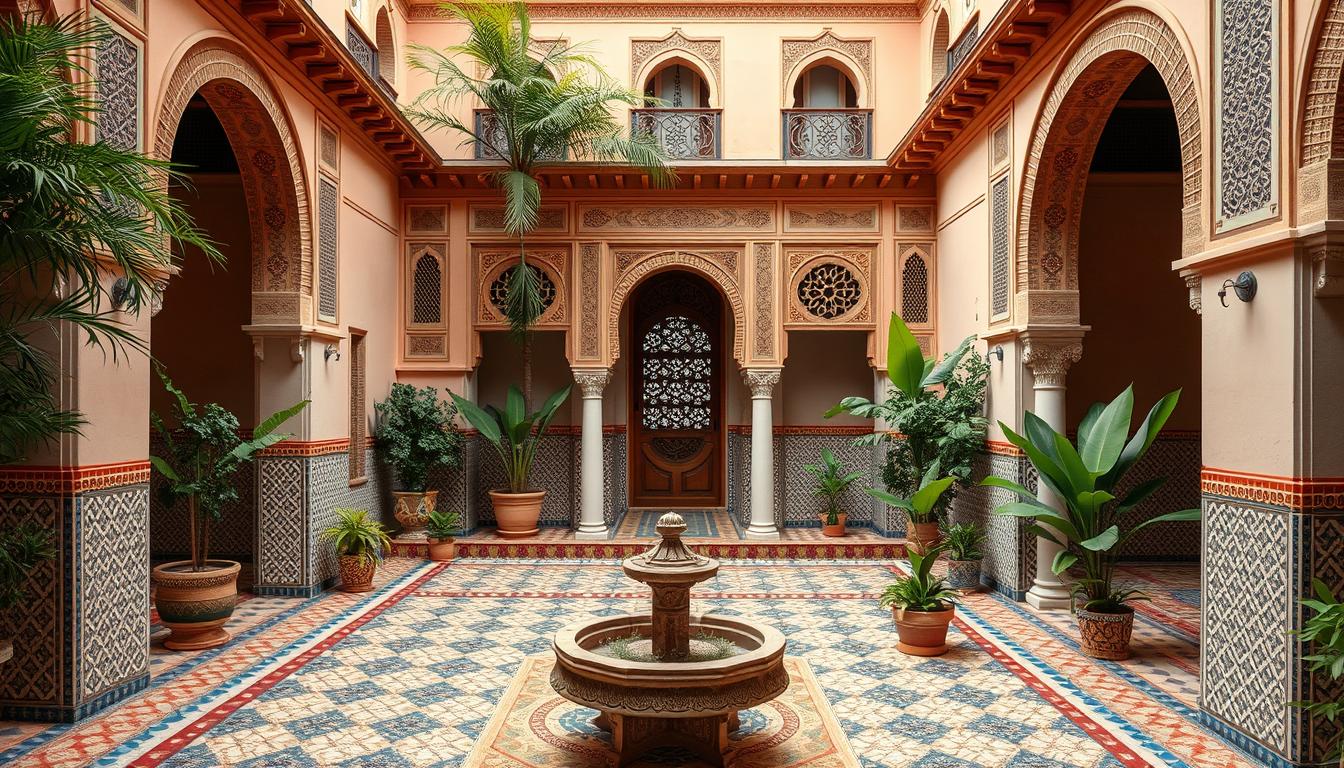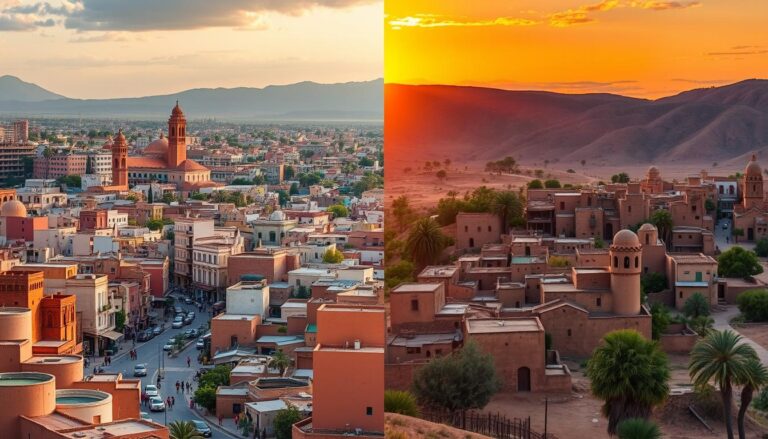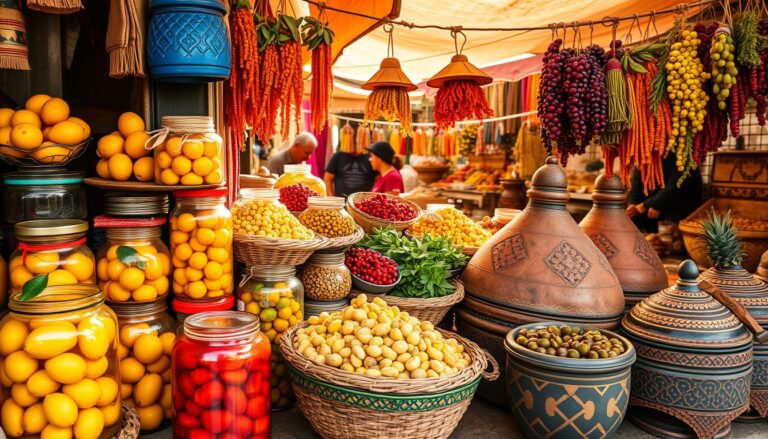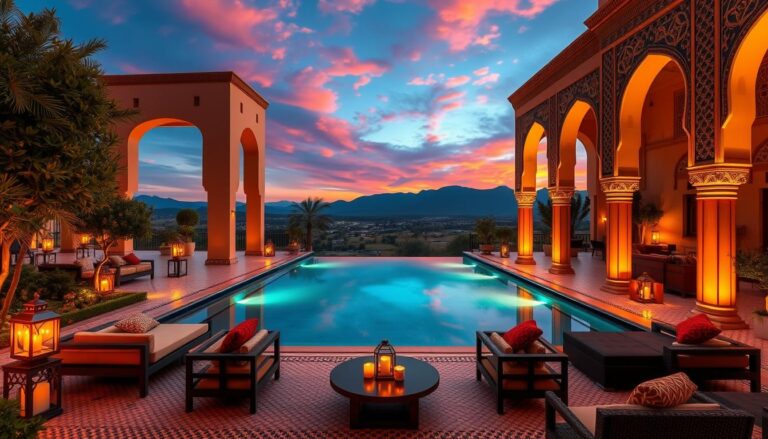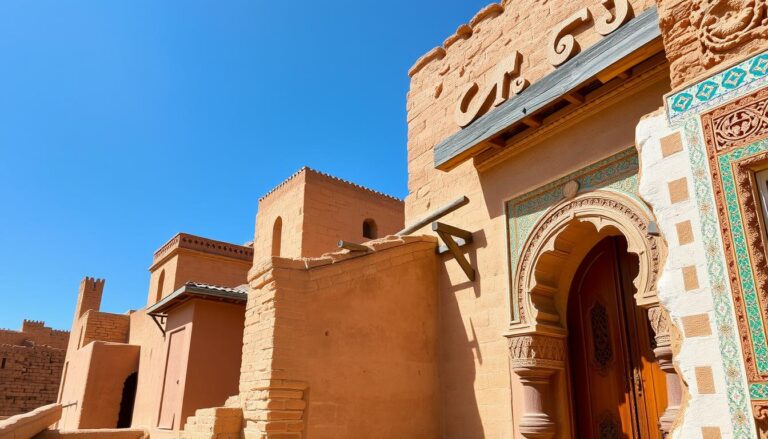In Morocco, architecture shows a blend of gender roles and design. For centuries, men and women’s cultural norms have influenced building styles. This mix of the feminine and masculine is seen in the buildings of this North African country.
Key Takeaways
- The traditional architecture of Morocco reflects deep-rooted gender roles and cultural norms.
- Feminine and masculine design elements are distinctly present in Moroccan homes and public spaces.
- Patriarchal influences have shaped the architectural styles, with power dynamics playing a significant role.
- Feminist critiques challenge the gender biases inherent in conventional Moroccan architecture.
- Inclusive design principles aim to incorporate women’s perspectives and break down traditional gender barriers.
Introduction to Moroccan Architecture
Moroccan architecture is a mix of history, culture, and Islamic design. It has been shaped by many cultures, from the Moorish era to today. By looking at its history and influences, we can understand what makes Moroccan buildings so special.
Historical Overview
Morocco’s architecture started with the Moorish era. During this time, Islamic styles greatly influenced design. Moroccan buildings began to feature intricate patterns, tilework, and famous arched doors and windows.
Influences of Moorish and Islamic Design
The Moorish influence on Moroccan architecture is clear. You can see zellige (intricate tilework), mashrabiya (carved wooden screens), and courtyards and fountains. These Islamic design elements add beauty and reflect the region’s culture and beliefs.
“Moroccan architecture is a captivating blend of historical influences, cultural traditions, and Islamic design principles.”
Over time, Moroccan architecture has been shaped by many factors. The country’s geography, climate, and traditional lifestyles have all played a part. These elements have made Moroccan buildings unique and diverse, inspiring people worldwide.
Gender Roles and Spatial Division
Traditional Moroccan architecture shows the clear gender roles and space divisions in the culture. The gender roles in traditional architecture are well-defined. This is seen in the gendered spaces in Moroccan homes and the clear lines between public and private domains. These divisions come from cultural norms shaping spatial division and religious beliefs.
In traditional Moroccan homes, women’s areas, like courtyards and private rooms, differ from men’s public spaces. These gendered spaces in traditional homes help keep women in the private sphere and men in the public area. This setup follows the gender roles in traditional architecture.
Public vs. Private Domains
The public and private domains in architectural design are shaped by culture and religion. Men usually occupy public areas like the main entrance and communal spaces. Women, on the other hand, are in the secluded, private parts of the home, with less access to public areas.
“The discursive division of space in Morocco places men in public roles and sectors, while women are relegated to the private space of the home.”
This division mirrors the cultural norms shaping spatial division and Morocco’s traditional patriarchal society. It limits women’s roles and movements to the home.
Gender Considerations in Traditional Architecture in Morocco
The traditional architecture of Morocco is deeply connected to the country’s gender dynamics and cultural norms. Homes and public spaces show how gender influences design. This section explores how gender roles, power, and societal expectations are reflected in Moroccan buildings.
Moroccan architecture is known for its Moorish and Islamic styles, shaped by patriarchal structures. The Hassan II Mosque in Casablanca, for example, took years to build with 10,000 artisans. Yet, it now faces structural damage, showing the need for inclusive design.
In traditional Moroccan homes, spaces are divided by gender. Men’s areas, like courtyards and formal rooms, were public. Women’s spaces were private, domestic areas. This division mirrors cultural norms and power dynamics.
“In 2002, structural damage to the Hassan II Mosque was reported, including pillars threatening to collapse, cracked concrete, and ruptured steel.”
As Morocco modernizes, it’s time to rethink its architecture. Adding women’s perspectives and challenging old norms can create more inclusive spaces. Architects and planners can help fight climate change and promote justice by doing so.
The architecture of Morocco shows the complex relationship between gender, culture, and power. Understanding these dynamics is key to creating a more inclusive and sustainable environment. This environment should meet the needs of all, regardless of gender.
Women’s Spaces and Feminine Design Elements
In Morocco, women’s spaces and feminine design elements are key parts of the architecture. They show the culture and social life of the area. They also show how women have shaped the buildings around them.
Courtyard Gardens and Fountains
Courtyard gardens are a big part of Moroccan architecture. They are seen as feminine spaces. Women use them for socializing, relaxing, and doing household chores.
Fountains and water features add to the calm feel of these courtyards. They make the space feel like a sanctuary. The design of courtyards, with lots of greenery and shade, shows women’s love for cool, peaceful places.
Decorative Tilework and Textiles
Women artists and artisans create the beautiful tilework and textiles in Moroccan buildings. These designs add a unique look to the architecture. They mix cultural traditions with personal touches.
The zellij tilework and kilim rugs are examples of this. They show the talent and creativity of Moroccan women.
“The courtyard, with its fountains and greenery, was a sanctuary for Moroccan women, a space where they could find solace and express their creativity through the design of textiles and tilework.”
These feminine design elements are important in Moroccan architecture. They show the big role women have played in building the environment. By using spaces and designs that women like, Moroccan architecture has become rich and diverse. It shows the many cultures and gender roles in the region.
Masculine Spaces and Architectural Features
Traditional Moroccan architecture has both masculine spaces and masculine architectural components. These areas are linked to male-dominated spaces like public areas and grand entrances. The article looks at how these elements shape the gender-based spatial organization and power dynamics in Moroccan buildings.
Between 1912 and 1950, Morocco’s architecture changed a lot. Buildings became more open, showing off their beauty and skill. The Bâlima hotel in Rabat is a key example of this change, thanks to a team effort to beautify the city.
The influence of Louis H-G Lyautey changed Rabat’s layout, but it also made it hard for traditional homes. The Bouregreg Valley project tries to mix old and new, showing how Morocco is blending its past with modern city planning.
“Moroccan architecture is evolving to address the challenges posed by uncontrolled urban growth, aiming to capture spatial features of historical vernacular towns and apply them to contemporary architectural design.”
The Group of Moroccan Modern Architects, GAMMA Group, focused on designs that fit the local climate and culture. They used natural light and air flow, and even patios, to make buildings sustainable and comfortable.
In cities like Casablanca, Morocco is moving towards a new kind of urban planning. This change aims to make cities denser and more varied. It’s a way to deal with rapid growth while keeping the charm of old towns in new designs.
Patriarchal Influences on Building Styles
The traditional architecture of Morocco shows the country’s strong patriarchal society. This society shapes the design and look of buildings. Women often have less visible roles, while men’s spaces are more prominent.
Religious and Cultural Norms
Moroccan architecture mirrors the country’s religious and cultural values. These values, rooted in patriarchy, influence how buildings are laid out. Driss Chraïbi’s novel “La Civilisation, ma Mère!…” (1972) sheds light on the struggles Moroccan women faced during French rule.
Power Dynamics in Design
The traditional architecture of Morocco shows clear power imbalances. Large, imposing buildings represent male power, while women’s spaces are often hidden. Touria Khannous’ work challenges gender roles in Morocco and Saudi Arabia, focusing on women’s legal rights.
Understanding the patriarchal roots of Moroccan architecture is key. It helps us see the need for designs that include everyone. We must work towards designs that reflect the diversity and experiences of all people.
Feminist Critiques and Inclusive Design Principles
In recent years, feminist scholars and architects have looked closely at traditional Moroccan architecture. They see how it reflects gender-based biases and patriarchal structures. They want a design that is more inclusive and challenges gender norms. This section talks about new design principles that aim to make spaces fair and representative, using women’s experiences and ideas from Morocco.
Challenging Traditional Gender Norms
Feminist critiques show how traditional Moroccan architecture has supported patriarchal power. For example, the strict division between public and private areas has kept women out of certain spaces. Changing these gender norms in design is key to making spaces more welcoming and fair.
Incorporating Women’s Perspectives
To balance the gender gap in architecture, it’s vital to include women’s views in design. This means working with women from different backgrounds to understand their needs. By doing this, designers can make spaces that meet the needs of everyone who uses them.
“Feminist architecture seeks to challenge the patriarchal norms and power structures that have dominated the field for centuries. It is about creating spaces that are truly inclusive and representative of all people, regardless of gender.”
Using inclusive design principles in Moroccan architecture could change the built environment. It could make it more fair, accessible, and responsive to everyone’s needs. By challenging gender norms and incorporating women’s perspectives, architects and designers can help create a more inclusive Morocco.
Conclusion
The traditional architecture of Morocco is a rich tapestry. It is woven together by the country’s cultural, religious, and gender-based dynamics. This article has explored how gender roles, power structures, and patriarchal influences have shaped the unique architectural styles found across Morocco.
From the gendered division of spaces to the integration of feminine and masculine design elements, the built environment reflects the deep-seated societal norms that have long governed the country.
A growing movement of feminist critiques and inclusive design principles is challenging these conventional gender biases. This movement is paving the way for a more equitable and representative architectural landscape in Morocco.
As the country continues to grapple with the lingering effects of colonial-era legislation and the persistent influence of patriarchal norms, the integration of gender considerations in Moroccan architecture offers a promising avenue. This avenue promotes cultural, social, and economic progress.
By embracing the diverse perspectives and experiences of all individuals, architects and designers in Morocco can create built environments that celebrate the richness of Moroccan culture. They can also foster a more inclusive and empowering future.
This shift towards gender-inclusive design approaches not only aligns with the country’s evolving social and legislative landscape. It also holds the potential to drive meaningful change in the realms of cultural expression, economic development, and community well-being.
Source Links
- Diversity in Rabat
- Nomadic architecture – mobility, gender, ritual
- Moroccan architecture
- How Moroccan Traditions Work
- BETWEEN HARSHA AND HARIRA: MOROCCAN WOMEN’S RELATIONSHIPS TO FOOD AND KITCHENSPACE
- Gender Regimes in the Middle East and North Africa: The Power of Feminist Movements
- The Emancipation of a Harem Girl: Resisting the Gendered Division of Space in Wafa Faith Hallam’s The Road from Morocco
- Women, Gender, and Politics in Morocco
- Morocco’s Built Environment: tradition, modernization and climate change – (ITD)
- Women architects: From slogans to struggle in making gender-inclusive cities – Question of Cities
- Environmental and socio-cultural transition from traditional courtyard dwellings to contemporary housing practices in Morocco: insights from Arab and East Asian regions – Journal of Umm Al-Qura University for Engineering and Architecture
- Women, Design and Democracy. What Future for the Mediterranean?
- AN URBAN PLANNING AND MODERN ARCHITECTURE OF THE TWENTIETH CENTURY IN MOROCCO: THE CONSTRUCTION OF A CAPITAL, RABAT
- “They have no taste in Morocco.” Home furnishing, belonging, and notions of religious (im)perfection among white Dutch and Flemish converts in Morocco – Contemporary Islam
- The Construction of Gender from the Male Perspective in Moroccan Novel
- Liberal Feminism Impact on Moroccan Educated Women: Faculty of Letters and Human Sciences, FLDM, as a Field Study
- 22 essential reads on feminist architecture, urbanism and gender and space – Master of International Cooperation Sustainable Emergency Architecture
- Gender Policy and Authoritarian Flexibility: The Women’s Quota in Morocco as an Instrument of Regime Support – ROWAQ ARABI
- Gender and Sexual Orientation in Postcolonial Morocco: An overview
- Closing Morocco’s Gender Gap Factsheet
- No title found

The Editorial Team is a passionate group of Morocco enthusiasts dedicated to sharing the beauty, culture, and wonders of this captivating country. With diverse backgrounds and a deep love for travel, we strive to bring you engaging and informative content that inspires your Moroccan adventures. From uncovering hidden gems and sharing local insights to exploring mouthwatering cuisine and showcasing the vibrant lifestyle, our team is committed to providing you with valuable resources and exciting stories that enhance your exploration of Morocco. Join us on this journey as we celebrate the rich heritage and unforgettable experiences that make Morocco truly special.

